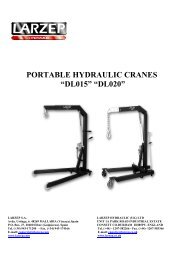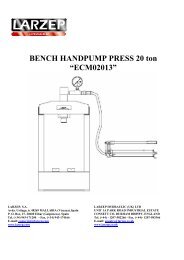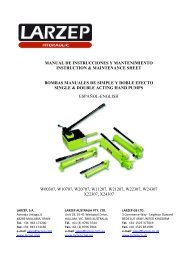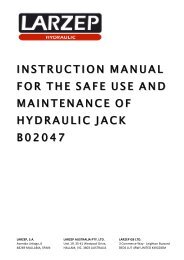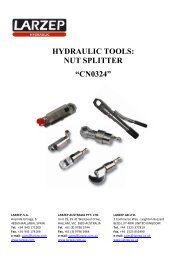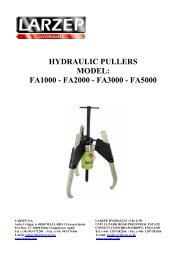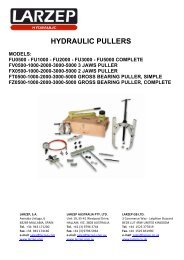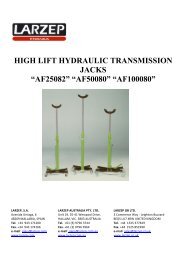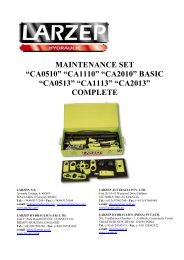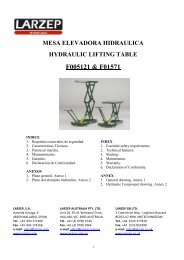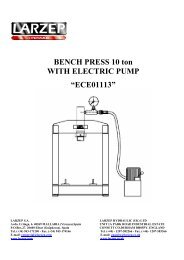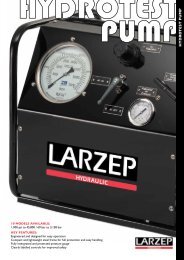W07807-X07807 - Larzep Australia Pty Ltd
W07807-X07807 - Larzep Australia Pty Ltd
W07807-X07807 - Larzep Australia Pty Ltd
You also want an ePaper? Increase the reach of your titles
YUMPU automatically turns print PDFs into web optimized ePapers that Google loves.
Instruction Manual<br />
Hydraulic Hand Pump “<strong>W07807</strong>”, “<strong>X07807</strong>”<br />
SINGLE ACTION INSTALLATION<br />
1. Place the distributor valve in central position.<br />
2. Pump manually; with the oil filling plug opened, several times to allow the entry of air in the pump and make easier the suction<br />
3. Close the plug by turning clockwise manually. You do not need to close too tightly.<br />
4. Place the distributor valve in advance position and pump using the drive lever. First, fill the hose with oil. The number of thrusts required will depend on<br />
the length of the hose and the flow supplied by the pump piston. With two-speed pumps, the large piston will be activated during the load-free feed<br />
movement, and when the device comes into contact with the load, an internal large piston relief value will be automatically triggered and only the oil<br />
supplied by the small piston will be available up to 700 kg/cm”, which is the maximum pressure for the device.<br />
5. Once the hose is full of oil, the cylinder piston will start to advance.<br />
6. If the cylinder has a mechanical limit switch capable of withstanding the maximum device pressure, continue pumping until the limit switch is reached.<br />
7. If any control elements (pressure gauges) are available, you will be able to see how the pressure increases along with the effort required moving the lever.<br />
8. Keep pumping until you obtain the maximum pressure (700 kg/cm”). In this way you will be able to check the correct functioning of the internal safety<br />
valve and the absence of oil leaks in the installation.<br />
9. Maintain pressure in the installation for a short period of time (1 minute) without pumping (central position), in order to check the correct functioning of<br />
the pump’s check valve.<br />
10. To retract the cylinder, place the distributor valve in return movement. If the cylinder has a return spring (SM, SMP, SMX, SH, TE, T, SAM, SAH, CY,<br />
KC) the piston will move back automatically. The return speed may be slow in some applications. In this case, we recommend the use of double effect<br />
cylinders. In the case of load return cylinders (SP,SX,SL,SSR,STR,STX), you will need to push the piston back using more or less force, depending on<br />
the size and position of the cylinder.<br />
11. In cylinders without a mechanical limit switch (SSR, STR, STX) this type of test cannot be carried out. If you do not have a test bench, you will have to<br />
test the installation using the actual load in the application. This operation should be carried out with extreme care by experienced personnel and<br />
maximum safety measures should be applied.<br />
12. Repeat the process as many times as necessary until you is comfortable handling the device.<br />
13. If using close or check valves, or working with various cylinders via flow distributors, remember to take into consideration the effect these accessories<br />
may have on the functioning of the device, and establish an operating procedure in order to avoid unwanted effects.<br />
DOUBLE ACTION INSTALLATION<br />
1. The connection of the quick plugs is, if possible, even more important here, since a bad connection will not only prevent the device from functioning, it<br />
may also generate excessive pressure build-up that may cause the cylinder to break. Take note of which hose connects to the thrust chamber and which to<br />
the return chamber.<br />
2. All double action LARZEP cylinders are equipped with a mechanical limit switch capable of withstanding the nominal pressure. You can therefore carry<br />
out the test described in the previous section. If you are working with another type of cylinder and are not 100% sure, do not carry out this test.<br />
3. Turn the control of the distributing valve to the central position and pump and few times to fill the internal channels with oil.<br />
4. Turn the lever to one side and pump. Oil will flow through the hose connected to the side to which the valve lever is rotated. If this hose is connected to<br />
the cylinder’s thrust chamber, the piston will move forward. The oil in the return chamber will flow freely through the other hose to the pump tank. Until<br />
the moment the cylinder connects with the load, flow is supplied by both the large and small pistons.<br />
5. Continue pumping until you reach the limit switch. At this moment an internal large piston relief value will be triggered, and only the oil supplied by the<br />
small piston will be available. Subject the installation to pressure to check for leaks.<br />
6. Stop pumping and check (preferably using a pressure gauge) that the installation maintains the pressure level.<br />
7. Turn the valve lever to the other side and pump. Oil will flow to the return chamber and the piston will move back. The oil in the thrust chamber will flow<br />
freely back to the tank.<br />
8. Repeat the processes as many times as necessary until you are comfortable handling the device.<br />
9. If using close or check valves, or working with various cylinders via flow distributors, remember to take into consideration the effect these accessories<br />
may have on the functioning of the device, and establish an operating procedure in order to avoid unwanted effects.<br />
5. MAINTENANCE.<br />
Checking the oil level.<br />
With the pump in vertical position, unscrew or pry off the plug (27). Check the level on the dip stick.<br />
This check must be carried out with the cylinder fully retracted. Excessive amount of oil in the tank will lead to internal pressures which will hamper the<br />
function of the pump.<br />
Filter the oil before filling up the pump.<br />
Once the equipment is being used the areas exposed to wear and oxidation must be cleaned and greased.<br />
BREAK DOWNS AND REPARATIONS<br />
THE CYLINDER DOESN´T REACH WORKING PRESSURE.<br />
Relief valve decalibrated (12) ____ Calibrate the valve.<br />
Retention ball valve failure (20) ____ Clean the seat and replace the ball.<br />
Closing ball valve failure (22) ____ Clean the seat and replace the ball.<br />
Pressure seal damaged (26) ____ Replace the seal.<br />
Cylinder pressure seal damaged (see cylinder) ____ Replace the seal.<br />
THE CYLINDER DOESN´T RETRACT<br />
Too much oil in the tank ____ Check the level.<br />
THE CYLINDER DOESN´T AVANCE<br />
Lack of oil in the tank ____ Check the oil.<br />
Couplers not fully inserted ____ Check couplers.<br />
Admission ball valve failure (19) ____ Clean the seat and<br />
replace the ball.<br />
Closing ball valve failure (22) ____ Clean the seat and<br />
replace the ball.<br />
4



